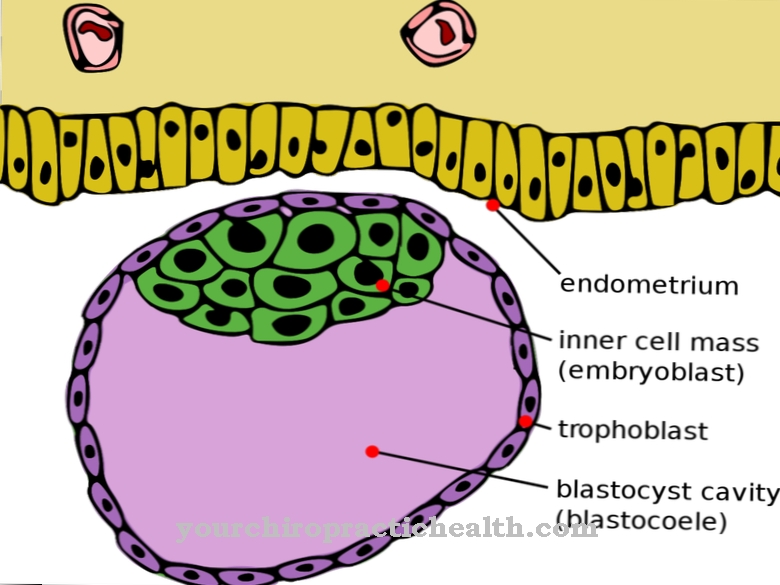Killer cells are part of the immune system. As so-called cytotoxic T cells (acquired immune system) or as natural killer cells (innate immune system), they recognize and attack cells foreign to the body and altered endogenous cells such as cancer cells, cells infected by viruses or bacteria or aging cells. The killer cells release substances that partially perforate the cell membrane of the attacked cells, so that programmed cell death, or apoptosis, is set in motion.
What is a killer cell?
Killer cells are an important part of the immune system. They recognize structures foreign to the body and altered body's own cells, for example cells infected by viruses or bacteria and cells that have degenerated into cancer cells.
Two different types of killer cells can be recognized, the so-called natural killer cells (NK cells), which are part of the innate immune system, and the cytotoxic T cells, which are part of the adaptive or adaptive immune system. To distinguish between friend and foe, the two cell types work with different systems. NK cells have certain receptors that are located in their plasma membrane and interact with so-called MHC-I molecules (Major Histocompatibility Complex), which show healthy endogenous cells on their surface.
If the MHC-I molecules are absent or certain molecules are missing - as is normally the case with cancer cells or cells infected by viruses, these are activated. While the NK cells work unspecifically, the cytotoxic T cells are characterized by their extreme specificity. In infected body cells, the MHC-I complexes also contain other peptides or other specific substances, so-called antigens. Cytotoxic T cells are each only specialized in recognizing a specific antigen.
Anatomy & structure
NK cells have their origin in lymphatic precursor cells that develop in the bone marrow and, after differentiating, are released into the blood and lymphatic systems. As a weapon against cells to be killed there are numerous lysosomes in their cytoplasm, which are everted when the NK cell is activated, so that the cytotoxic substance that is in the lysosomes is released and the target cell is lysed.
An important anatomical feature are two different types of receptors on their surface. They are inhibiting and activating receptors that react with the MHC-I molecules, present the target cells on their surface and activate or inactivate the NK cells. Cytotoxic T cells also originate from the bone marrow, but for their differentiation they take the detour via the thymus, which has given them the name T cells.
In the thymus, the cells differentiate into T cells and receive their specific T cell receptor before they are also released into the bloodstream. Their specific receptor consists of a protein complex that they carry on their surface and recognize specific antigens that are presented to the target cells together with the MHC-I molecules.
Function & tasks
The main task of the killer cells is the identification and immediate destruction of infected cells and degenerated tumor cells with viruses or other intracellular pathogens. The two different types of killer cells, the NK cells and the cytotoxic T cells, are available to fulfill the task. The evolutionarily much older NK cells have the ability to check the “ID cards” of the target cells and their MHC-I molecules for presence and completeness. If the NK cells encounter cells with incomplete MHC-I molecules or cells without recognizable MHC-I molecules, the NK cells attack immediately.
They release substances that lyse the cell membrane of the attacked cells. In the attacked cell, apoptosis is usually triggered, programmed cell death, which includes a kind of self-destruction with defined fragments, which are largely reintroduced into the intermediate metabolism. Macrophages then phagocytose the debris and transport them away. The evolutionarily much more "modern" cytotoxic killer cells are only specialized in one particular antigen via their specific receptors, so they do not recognize any other antigens, but have more options if they are activated.
They can mature into T helper cells or cytotoxic T cells at high speed and become active accordingly. They release perforins to lyse the target cell's membrane and granzymes that trigger apoptosis. In addition, they secrete interleukins and interferons, regulatory peptides that control the immune response to a viral infection.Since a cytotoxic T cell can only recognize “its” specific antigen, the thymus must produce cytotoxic T cells for each type of antigen, of which there are probably several million.
The advantage of specialization is that the immune system can adapt to new requirements, e.g. B. to continuously modified viruses can adjust. There is practically a constant race between the adaptive immune system and the genetically altering viruses. In order not to constantly have to keep a large reservoir of every T-cell needed, the thymus produces long-lived memory cells that serve as a basis for combating renewed infection with the corresponding pathogen and make the immune response 100 times faster.
You can find your medication here
➔ Medicines to strengthen the defense and immune systemDiseases
The work of the killer cells is very dynamic and is also subject to hormonal control. For example, an acute stress event leads to an increased proliferation of NK cells and increased vigilance, so to speak to the red alert.
The specifically effective cytotoxic T cells are slowed down because they could hardly make a helpful contribution during an acute situation that requires quick responses. In the case of chronic stress, however, the entire immune system is weakened. All types of killer cells decrease in number and in their vigilance, so that the susceptibility to infection increases.
One of the most important diseases in connection with cytotoxic T cells are autoimmune diseases, in which the killer cells do not recognize the body's own cells as such, but attack them and form corresponding autoimmune antibodies. The mechanism for the development of autoimmune diseases is not yet fully understood. It is generally accepted that genetic factors play at least a favorable role here.













.jpg)

.jpg)
.jpg)











.jpg)